A default installation of Outlook 2010 supports the following types of e-mail accounts:
Exchange You can configure Outlook 2010 to connect to an Exchange account hosted on Microsoft
Exchange Server 2010, Exchange Server 2007, or Exchange Server 2003. If
your organization runs any of these versions of Exchange Server, you
can send mail within or outside of your organization's network. Messages
are stored centrally on the Exchange server. They are also stored
locally in a data file on your computer. Outlook synchronizes with the
server when you're connected to it either over a corporate network or
over the Internet, so you can work with existing Outlook items and
create new items while working offline. If
your computer is connected directly to the corporate network, Outlook
handles the connection to your corporate Exchange account for you. If
your computer is not connected directly to the corporate network—for
example, if you're configuring your home computer or portable computer
to connect to your corporate Exchange account—you can connect to your
corporate Exchange account in one of two ways: You can create a virtual
private network (VPN) connection from your computer to the corporate
network and then configure Outlook to connect to the corporate Exchange
server through the VPN connection. You can configure Outlook to connect to the Exchange server over the Internet by using Outlook Anywhere (a vaguely friendly name for a service otherwise known as HTTP over RPC). The Exchange server must be specifically configured to allow this type of connection.
Tip:
Some Outlook features
are dependent on the functionality of the specific version of Exchange
hosting your e-mail account.
Post Office Protocol (POP) When connected to a POP account, Outlook downloads (copies) messages from your e-mail
server to your computer, and then removes the original messages from
the server after a specified length of time. You read and manage
messages on your computer (or locally), and Outlook synchronizes with the server when connected. Internet Message Access Protocol (IMAP)
When connected to an IMAP account, Outlook stores copies of messages on
your computer, but leaves the originals on the e-mail server. You read
and manage messages locally, and Outlook synchronizes with the server
when connected.
Tip:
Outlook 2010 can also support Windows Live Hotmail accounts.
Before you can use Outlook,
you need to configure the program to connect to your e-mail account(s).
When you first start the program, the Microsoft
Outlook 2010 Startup wizard guides you through an automated process.
This process is a significant improvement over the manual account setup
process of Outlook 2003 and earlier versions of Outlook, which required
you to provide much more information. For most accounts, you need to
supply only three pieces of information—your name, your e-mail address,
and your e-mail account password—and the Startup wizard will handle the
rest of the connection process for you. If the Startup wizard isn't able
to configure Outlook to connect to your account, you can provide
additional information to complete the process manually.
Configuring Outlook
creates an Outlook profile, which stores information about your e-mail
accounts. You can work with your profile from within Outlook or from the
Mail control available in the Windows Control Panel. Your profile
includes information about your e-mail account such as the user
name, display name, server name, password, and where your Outlook data
is stored. You can connect to more than one e-mail account per profile,
to manage all your e-mail communications through Outlook. You can also
create multiple profiles that link to different e-mail accounts or to different sets of e-mail accounts.
You can add multiple e-mail accounts of any type to your Outlook profile, either during setup or at any time thereafter.
In this exercise, you'll configure Outlook
to automatically connect to an e-mail account and you'll manually
configure Exchange account settings. Although we demonstrate connecting
to an Exchange account, you can follow the same basic process to connect
to another type of e-mail server.
Note:
SET UP
You need your e-mail account user name and password to complete this
exercise. If you are connecting to a POP account, an IMAP account, or an
Exchange account that is hosted by an external service provider, you
might also need to know the names and authentication requirements of
your incoming and outgoing servers. These will be available from your
e-mail service provider.
On the Start menu, click All Programs, click Microsoft Office, and then click Microsoft Outlook 2010.
Tip:
If the E-mail link at the
top of the Start menu specifies Microsoft Outlook as your default e-mail
program, you can click that link instead.
The next step depends on whether Outlook is already configured to connect to an e-mail account. If you haven't yet configured Outlook to connect to an e-mail account, the Microsoft Outlook 2010 Startup wizard begins.
The Outlook 2010 Startup wizard.
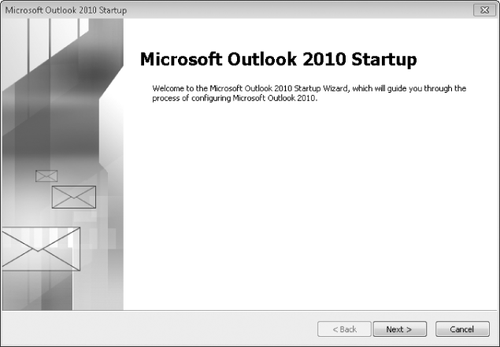
On the Startup wizard's Welcome page, and again on the E-mail Accounts page, click Next. If
Outlook is already configured to connect to one or more e-mail
accounts, Outlook starts and displays the Inbox of an existing account.
You need to manually start the account configuration process. Click the File tab at the left end of the ribbon to display the Backstage view. Then on the Info page of the Backstage view, under the current account information, click Add Account.
You add an account to Outlook from the Backstage view of the program window.

Tip:
You control Outlook
program settings and e-mail account settings from the Backstage view.
Whether you followed step 2a or step 2b, the Auto Account Setup page of the Add New Account wizard is now displayed.
The Add New Account wizard, which you open from the Startup wizard or from the Info page of the Backstage view.

On the Auto Account Setup page of the Add New Account wizard, enter your name, e-mail address, and e-mail account password in the text boxes provided. Note that you must enter your password two times.
The
password characters you enter are hidden, so ensure that the Caps Lock
key is not inadvertently active when you enter the password.

On the Auto Account Setup page, click Next. The Add New Account wizard searches your available networks and the Internet for the specified domain.
The
wizard searches for the domain that hosts your account and attempts to
log on to it by using the credentials you provided in step 3.
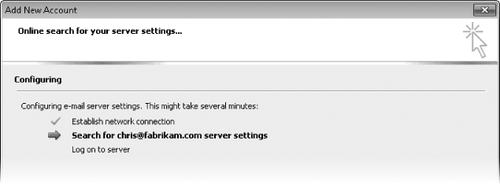
If the wizard
locates an account matching the e-mail address you entered, it attempts
to log on by using the password you entered. If the connection is
successful, a confirmation appears, along with additional account
configuration options. You can click Finish on the wizard's final page
to begin using your account, or you can configure additional settings.
After
successfully configuring a connection to an e-mail account, you can
modify the account's server settings, add another account, or click
Finish to begin using the account.
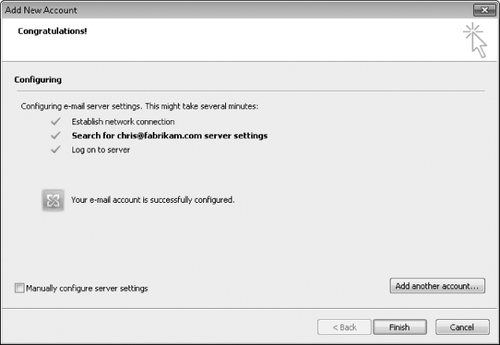
Tip:
If this is the first time
you have started a 2010 Microsoft Office system program, Office prompts
you to enter your full name and initials. The programs in the 2010
Office system use this information when tracking changes, responding to
messages, and so on. Next, Office prompts you to select the type of
information you want to share over the Internet, and finally, offers the
option of signing up for automatic program updates from the Microsoft
Update service.
If the wizard successfully connects to your account, select the Manually configure server settings check box, click Next, and then skip to step 12 to practice configuring additional settings. If the wizard is unable to connect to your account by using the credentials you provided, an informational message appears.
The specific message you see might differ from the one shown here.
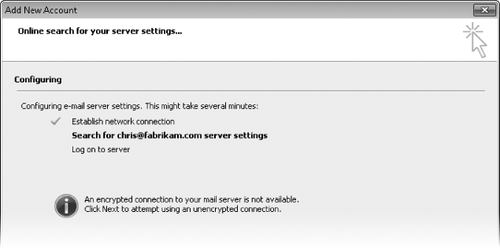
If the wizard doesn't connect to your account, click Back to return to the Auto Account Setup page (shown in step 3 of this exercise). Then click Manually configure server settings or additional server types, and click Next. The Choose Service page opens.
Depending
on the information entered on the Auto Account Setup page, the Other
option might or might not appear on the Choose Service page.
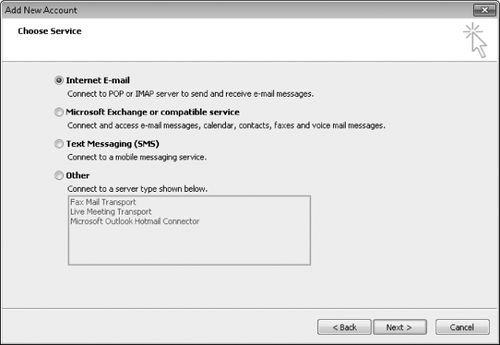
On the Choose Service page, click Microsoft Exchange, and then click Next.
Note:
The screen that appears
next varies based on the selected account type. For the purpose of this
exercise, we'll connect to an Exchange account.
Tip:
It's more likely that you need
to perform manual configuration when connecting to an Internet e-mail
account than to an Exchange account.
On the Microsoft Exchange Settings page, enter the name or address of your Exchange server (provided by your Exchange server administrator) and your user name (usually your e-mail address) in the boxes provided, and then click Check Name. If you didn't provide your password on the Auto Account Setup page, Outlook prompts you for it now. If the Connect to dialog box appears, enter your logon information, and then click OK. The
wizard contacts the specified server. If the user name and password you
provided match the information stored on the server, the wizard
replaces your user name with your display name (as recorded in your
organization's Global Address List) and underlines it. (This is known as
resolving the address.) If the wizard is unable to validate the information, a Microsoft
Exchange dialog box opens. This might occur if you're connecting to a
corporate Exchange server over the Internet, and Outlook requires
additional information to establish the connection.
Possible results of attempting to validate Exchange account credentials.

If the Microsoft Exchange dialog box opens, click Cancel and then wait for the wizard to return to the Microsoft Exchange Settings page. If the wizard successfully resolves your server name and user name, you can click Next and then Finish to begin using your account, or you can manually configure additional account settings. For the purpose of this exercise, we'll look at the manual configuration options. On the Microsoft Exchange Settings page, click More Settings. A
Microsoft Exchange account settings dialog box opens, displaying the
General page. On this page, you can specify the name that identifies the
account within Outlook (for example, on the program window title bar
and in the Navigation Pane). This action does not affect the name that
appears to message recipients.
The General page of the Microsoft Exchange account settings dialog box.
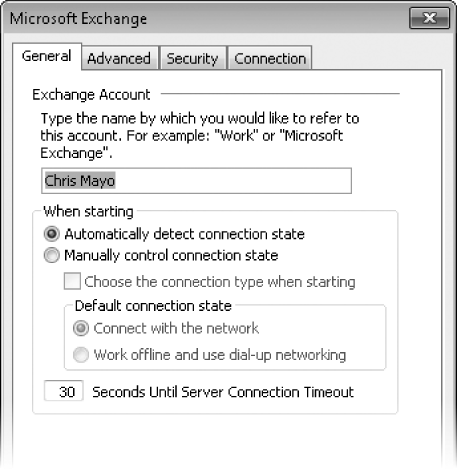
Click each of the dialog box page tabs to review the available settings. On the Advanced page, you can specify additional mailboxes
on the same Exchange server that you want to open in Outlook. For
example, if you monitor a departmental mailbox, you can specify it here.
The Advanced page of the Microsoft Exchange account settings dialog box.
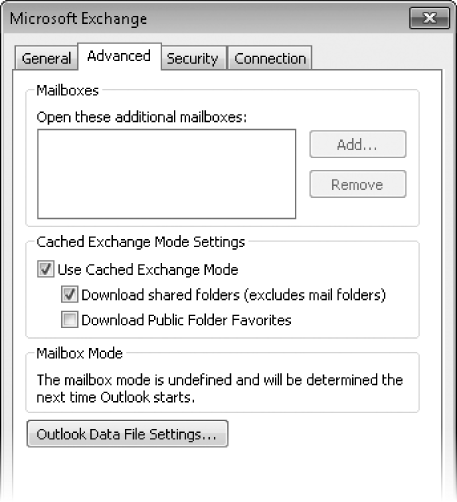
On the Security page, you can choose to secure your locally stored account data by requiring logon credentials each time you start Outlook.
The Security page of the Microsoft Exchange account settings dialog box.

Tip:
Clicking Outlook Data File
Settings on the Advanced page of the Microsoft Exchange dialog box
displays the path to and name of the data file on your computer in which
a local copy of your e-mail account information is stored.

From the Outlook
Data File Settings dialog box, you can reduce the data file size by
compacting its contents or disable offline use of the local data file so
that account information is available only when Outlook is connected to
the Exchange server.
On
the Connection page, you can select the way you want Outlook to connect
to the Exchange server. The default connection option, Connect Using My
Local Area Network, is appropriate for any wired or wireless broadband
network connection.
The Connection page of the Microsoft Exchange account settings dialog box.

If you connect
to the network through an analog modem and need to dial in over a phone
line, you need to select one of the other options and provide the
necessary dial-up network connection information.
Tip:
You create network
connections from Windows. For information about creating a network
connection from the version of Windows running on your computer, refer
to Windows 7 Step by Step (Microsoft Press, 2009), Windows Vista Step by Step (Microsoft Press, 2007), or Windows XP Step by Step (Microsoft Press, 2004) by Joan Lambert Preppernau and Joyce Cox.
In the Microsoft Exchange dialog box, enter any additional connection information provided to you by your Exchange server administrator, and then click OK. On the Microsoft Exchange Settings page, click Next. Then on the wizard's final page, click Finish. The E-mail page of the Account Settings dialog box might appear and display the new e-mail account.
Your account is ready to use.
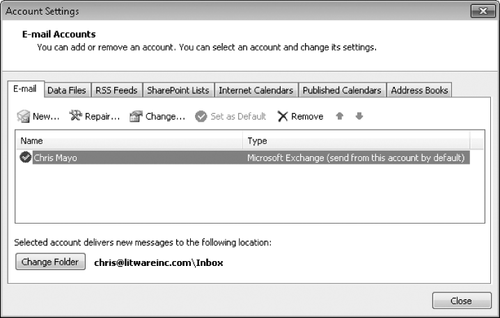
If the Account Settings dialog box opens, close it to display your e-mail account Inbox. A test message from Outlook appears at the top of the Inbox, with your other e-mail messages below the test message.
Note:
CLEAN UP You're now ready to begin using your e-mail account!
Windows
Live Hotmail accounts are Hypertext Transfer Protocol (HTTP) accounts.
Messages sent through an HTTP account are in the form of Web pages that
your e-mail program copies from the HTTP mail server and displays within
the message window.
The free Microsoft Outlook Hotmail
Connector add-on provides a way to configure Outlook to connect to
Windows Live Hotmail accounts, Windows Live Calendar, and Windows Live
Contacts. The Outlook
Connector add-on is available from the Microsoft Download Center
(www.microsoft.com/downloads/). However, you can also install it
directly from Outlook. Simply enter your Hotmail e-mail address on the
Auto Account Setup page of the Add New Account wizard, and click Next.
Outlook prompts you to install the Outlook Connector and provides a link
to the installation file.
After you install the
Outlook Connector, restart Outlook. The Outlook Connector then gives
you the opportunity to configure Outlook to connect to a Hotmail
account. You need to enter only your basic account information. You have
the option to specify a friendly name by which you identify the account
in Outlook, and an alternate reply address, just as you can with an
Internet e-mail account.
To connect to a Hotmail account, you must first install the Outlook Connector.
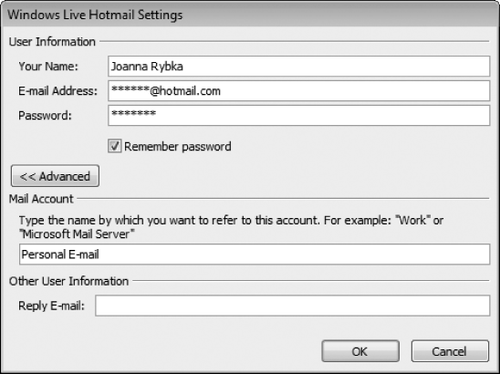
After you complete the Outlook
Connector process, you can use your Hotmail account within Outlook
exactly as you do any other type of account.
|